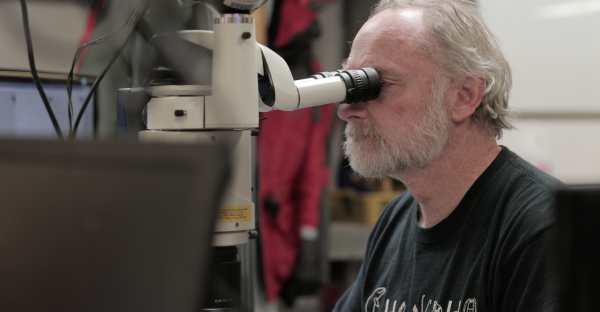Sikuliaq expands ways to study Gulf of Alaska ecosystems
August 7, 2018
Lauren Frisch
907-474-5350
New funding and the use of the research vessel Sikuliaq have revolutionized data collection in the Gulf of Alaska by increasing the space
and workforce available to conduct complex experiments at sea.
With 20 years of research and data to support their efforts, scientists in the Northern
Gulf of Alaska Long-term Ecological Research program strive to better understand how
physical processes and climate variability influence the base of the food web in the
productive northern Gulf of Alaska. Led by researchers from the University of Alaska
Fairbanks College of Fisheries and Ocean Sciences and their collaborators, the first
LTER research expedition on Sikuliaq concluded in May 2018.

This is the first story in a four-part series documenting successes and preliminary findings from that expedition.
The Gulf of Alaska supports a diverse ecosystem that includes several commercially important fisheries, as well as culturally and economically important marine mammals and birds. All of these species are fueled by tiny organisms at the base of the food chain. Observations indicate that changes in these communities of tiny organisms are linked to climate variability, but these links are poorly understood. Researchers want to better understand these links so they can evaluate how the gulf’s fisheries and marine mammals may be impacted by changes in the environment.
The LTER program brings in $5.6 million in funding over the course of five years. Before the LTER site was established, researchers were able to study the distribution of species in each region, but had limited abilities to investigate what those species were doing or how they were affected by their ecosystem. With the new LTER funding and the use of Sikuliaq, the scope of the project has expanded substantially to study specific biological and physical processes that drive environmental variability in the Gulf of Alaska.
“It’s kind of like we moved from working out of a tiny camper van to working out of an entire house,” explained CFOS researcher Russ Hopcroft, the principal investigator for the project. “The ship we have been using in the past could easily fit on the back deck of Sikuliaq.”
The UAF-operated Sikuliaq, a 261-foot vessel, has abundant lab space inside, including a walk-in refrigerator that allows for controlled temperature experiments and a computer room that allows researchers to display data from all of the ship’s onboard data systems at the same time.
“Working on Sikuliaq is a game changer,” Hopcroft said. “Because the ship is bigger, she is more stable in the stormy Gulf of Alaska and is therefore able to operate in a wider range of conditions. We can have twice as many researchers onboard, and the increase in lab space opens up the opportunity to conduct complex experiments at sea.”

Hopcroft is a biological oceanographer who studies copepods and other animal plankton in the ocean. For his experiments, he needs to be able to identify different types of copepods through microscopes, and then use special eye-droppers to isolate each copepod he wants to use. This is hard enough on its own; now insert a rocking, bumpy research vessel.
Hopcroft’s experiments have been constrained in the past because of limited opportunities on small vessels to work with live animals and execute complex procedures. For many genetic and physiological experiments, you need to work with the tiny critters under a microscope immediately after capture, Hopcroft explained, or they begin to degrade and can no longer be used. On past Seward Line cruises, Hopcroft was lucky to set up a single microscope on the ship.
On Sikuliaq, Hopcroft was able to spread out and comfortably set up four microscopes, allowing his team to quickly look at samples as soon as they came on deck, take pictures of them, preserve what they needed, and assess whether additional sampling was necessary at certain locations.
“That’s one of the things that makes the LTER expansion interesting and exciting,” Hopcroft said. “For years we’ve only been able to go out and say who we see, but not dig into much detail about what the critters are doing.”
The NGA LTER is anchored on a 20-year effort to monitor ocean conditions and biological species along the Seward Line, a series of oceanographic survey stations that runs from the mouth of Resurrection Bay across the continental shelf to a location 170 miles offshore. CFOS researchers have been sampling these stations every May and September since 1997.
The Seward Line program began as part of the U.S. Global Ocean Ecosystem Dynamics program, jointly funded by the National Science Foundation and National Oceanic and Atmospheric Administration. Over the past two decades, the program has received additional support from the North Pacific Research Board, Alaska Ocean Observing System and Exxon Valdez Oil Spill Trustee Council. NSF added funding for the expanded NGA LTER site for five years in fall 2017.
The next story in this series talks about the coolest gadget on the NGA LTER cruise: an underwater Acrobat.
Read more here on the new LTER research site.



